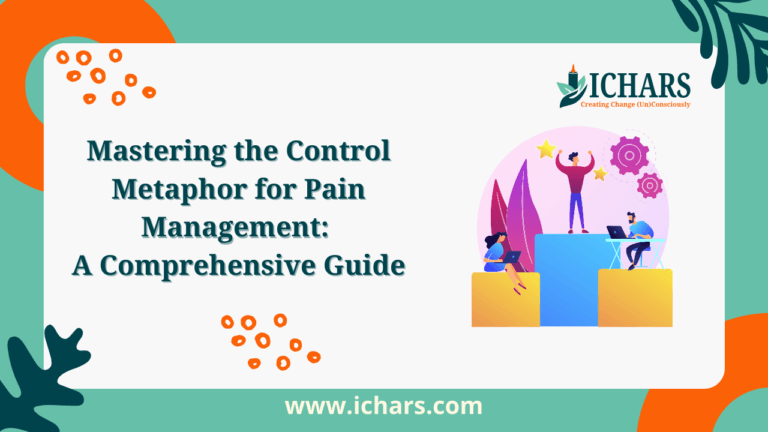Introduction: A New Era in Pain Management
Pain is an inevitable part of the human experience, but the way we respond to it can make all the difference. Whether it’s physical or emotional, pain has the power to control us—until we learn how to control it.
The Control Metaphor is a groundbreaking technique that transforms how we approach pain management. By shifting the focus from symptom relief to empowerment, the Control Metaphor allows clients to not only manage their pain but gain mastery over it.
This article is a deep dive into the Control Metaphor, exploring its psychological roots, the neuroscience behind its effectiveness, its application in therapy, and how it can radically shift the therapeutic process.
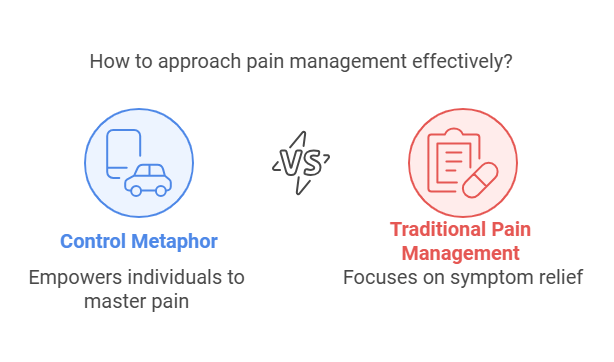
We’ll examine why this technique is so powerful, how it can be applied in your practice, and why it represents a paradigm shift in how we think about healing.
The Control Metaphor: Shifting the Paradigm in Pain Management
At first glance, pain management might seem like a straightforward task: provide relief. But as every therapist knows, true healing doesn’t come from simply masking the symptoms.
It comes from empowering the client, helping them build the tools they need to manage their emotions and pain for a lifetime. The Control Metaphor is not just a tool—it’s a transformative process that shifts the way your clients interact with their pain.
The Root of Suffering: Control and the Illusion of Powerlessness
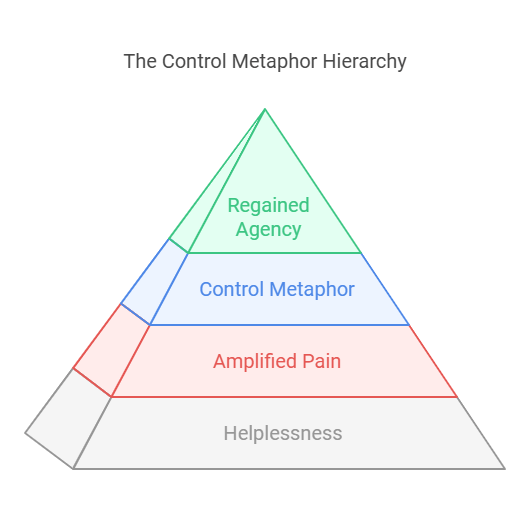
Pain, whether physical or emotional, is often exacerbated by the feeling of helplessness. When people believe they have no control over their experience, they spiral into a state of anxiety and helplessness. This is the root of suffering.
Research shows that when individuals feel powerless, their brains are more likely to amplify pain and stress, increasing the severity of the discomfort.
The Control Metaphor, however, offers clients a direct pathway out of this cycle. It taps into the brain’s natural desire for mastery and control, giving clients the ability to manage their internal experiences.
This is why the metaphor works so well: by engaging clients in a process where they control their pain, they regain their agency, reducing the emotional and physical intensity of the experience.
Understanding the Neuroscience of Control: Why the Metaphor Works
To truly appreciate the Control Metaphor, it’s crucial to understand the neurological mechanisms that make it so effective. Pain and emotions are processed in the brain through neural pathways that can be influenced by mental states.
When individuals feel in control, their brains release neurochemicals – such as endorphins and dopamine – that naturally reduce pain perception.
The Role of the Subconscious Mind
The subconscious mind plays a central role in both the experience and management of pain. Our brain is hardwired to respond to threats, and when pain is perceived as a threat, the body reacts in ways that increase the intensity of the pain.
This is where the Control Metaphor becomes powerful. Through guided imagery and subconscious engagement, clients are able to reframe their experience of pain.
By visualizing a control panel, where each dial represents different emotional or physical states, clients can symbolically take control of their pain. This exercise doesn’t just distract the brain – it actively rewires how the brain interprets pain.
When the client imagines reducing the intensity of their pain by adjusting a mental dial, the brain responds by lowering the perceived intensity of the sensation.
A Step-by-Step Guide to the Control Metaphor Process
Now that we’ve explored the science and psychology behind the Control Metaphor, let’s break down the step-by-step process of how you can use it with your clients.
While the metaphor is simple, its impact is profound. By following these steps, you’ll guide your clients through a transformative process that helps them regain control of their emotional and physical states.
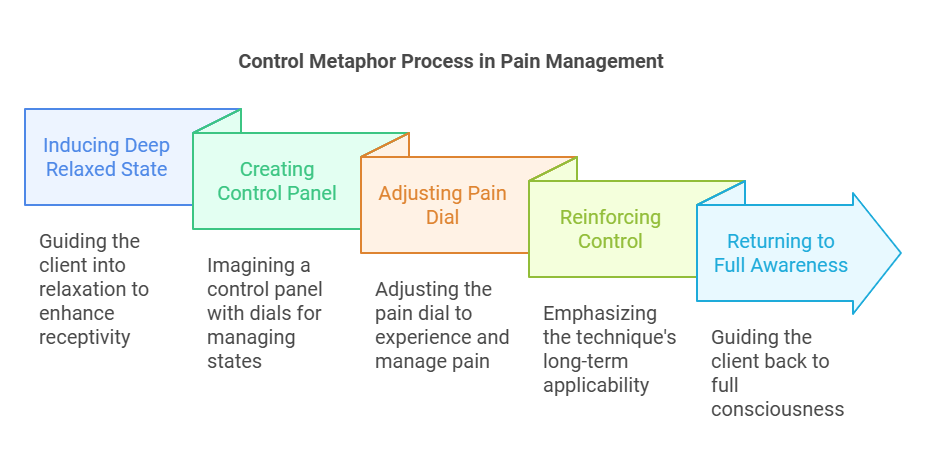
Step 1: Inducing a Deep Relaxed State
The first step is to guide your client into a deeply relaxed state. Relaxation is critical because it allows the subconscious mind to become more receptive to suggestion and visualization.
Use progressive relaxation techniques, such as asking your client to focus on their breath or body, progressively releasing tension from head to toe. The deeper the relaxation, the more profound the shift in their pain perception will be.
Step 2: Creating the Control Panel
Once your client is fully relaxed, it’s time to introduce the control panel. Guide them to imagine walking down a corridor leading to a peaceful, personal space. In this space, they’ll discover a control panel—an advanced, futuristic device with various dials.
Each dial represents a different aspect of their emotional or physical state. This could include dials for pain, fear, stress, anxiety, or other sensations they wish to manage.
The key is to allow them to engage fully in this visualization. Ask them to notice the colors, shapes, and sounds of the control panel, making it as vivid as possible in their mind’s eye. This level of detail helps strengthen the connection between the metaphor and their subconscious mind.
Step 3: Adjusting the Pain Dial
Next, ask your client to identify which dial corresponds to the pain or emotion they wish to manage. Have them rate the intensity of their pain on a scale from 1 to 10. This serves as a baseline, grounding them in the current state of their pain.
Once they’ve rated it, encourage them to slowly adjust the dial to the right, increasing the intensity. This step, while seemingly counterintuitive, allows them to truly experience their pain in a controlled manner, making it less overwhelming.
Then, guide them to slowly adjust the dial back to the left, reducing the intensity by increments. Encourage them to focus on the sensations in their body as they turn the dial, noticing how their experience of the pain shifts.
With each adjustment, they’ll begin to feel more control over their physical and emotional experience.
Step 4: Reinforcing Control for Long-Term Use
Once your client has successfully adjusted the pain dial and felt a reduction in intensity, reinforce the idea that this process can be repeated at any time. Empower your clients to carry this technique with them outside of the therapy room.
Remind them that while this technique doesn’t eliminate the root cause of their pain, it gives them a powerful tool to manage it effectively.
Tell them that every time they use the Control Metaphor, they’ll strengthen their ability to regulate their pain and emotions. Over time, they’ll develop a stronger sense of control, making them less dependent on external interventions.
Step 5: Returning to Full Awareness
Finally, guide your client back to full awareness. Encourage them to open their eyes, stretch, and reorient themselves to the present moment. Remind them that the Control Metaphor is a tool they can use anytime they need it.
Encourage them to practice regularly, so that it becomes an automatic response when pain or anxiety arises.
The Transformational Power of the Control Metaphor
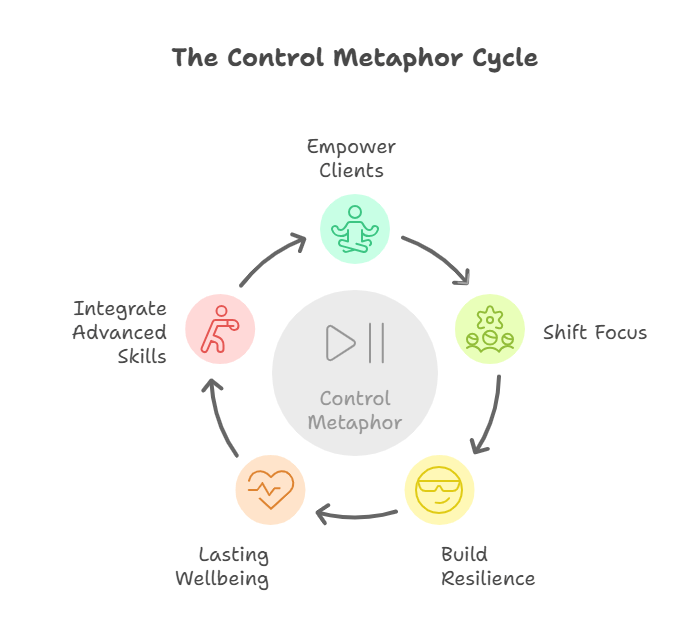
The Control Metaphor is not just a temporary relief tool—it’s a transformational technique that helps clients permanently alter their relationship to pain.
It empowers clients to take back control over their emotional and physical experiences, offering a profound shift in their ability to manage discomfort.
Lasting Impact on Emotional and Physical Wellbeing
By integrating the Control Metaphor into your therapeutic practice, you are providing your clients with not just a coping mechanism, but a lifelong skill that will serve them beyond the therapy room.
When clients feel empowered to manage their pain and emotions, they can navigate life’s challenges with greater resilience and confidence. This approach to pain management is especially effective for clients dealing with chronic pain, anxiety, and other emotional difficulties.
By shifting their focus from fixing their problems to managing them, they gain agency over their healing process, which is incredibly empowering and healing in itself.
Take Your Practice to the Next Level with Advanced Skills
The Control Metaphor is just one of many advanced tools you can learn to transform your therapy practice. By integrating techniques like the Control Metaphor, you can help your clients take meaningful steps towards emotional and physical wellbeing.
To deepen your expertise and gain access to more powerful therapeutic techniques, consider enrolling in the Cognitive Hypnotic Psychotherapy Diploma. This advanced program will equip you with the skills and tools to create deep, lasting change for your clients.
